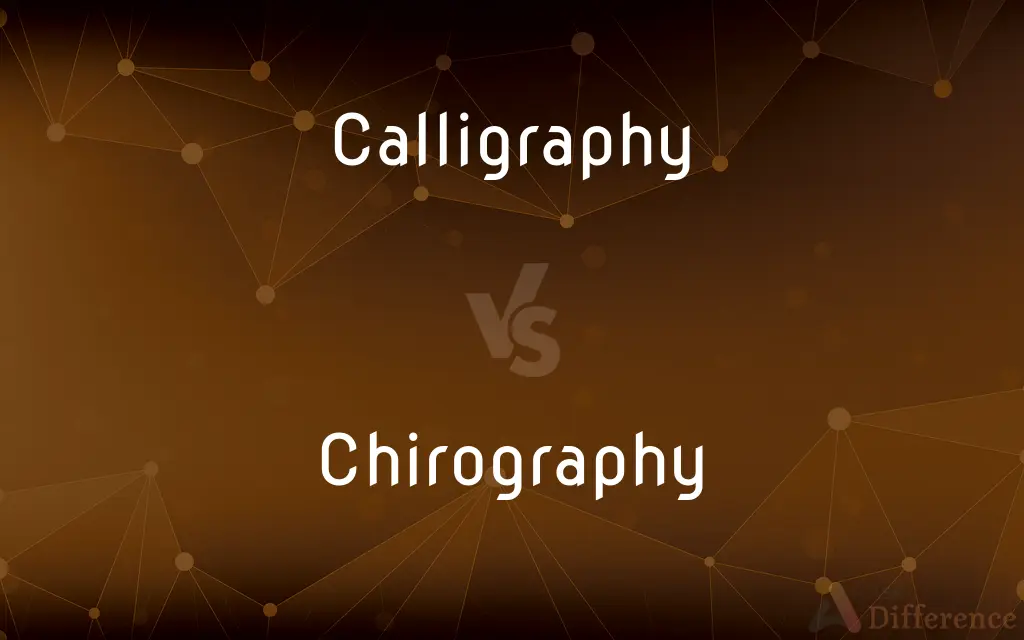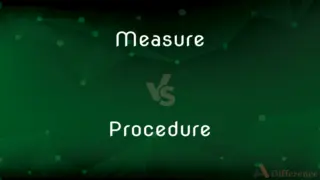Calligraphy vs. Chirography — What's the Difference?
By Fiza Rafique & Urooj Arif — Updated on April 15, 2024
Calligraphy is the art of beautiful handwriting using special tools and techniques, while chirography refers to any handwriting style or penmanship.

Difference Between Calligraphy and Chirography
Table of Contents
ADVERTISEMENT
Key Differences
Calligraphy focuses on the aesthetic and decorative aspects of writing, often employing broad-tipped instruments, brushes, or other writing tools to create artistic letterforms. Chirography, on the other hand, encompasses all forms of handwriting, regardless of aesthetic quality.
While calligraphy is often learned through formal training and practiced as an art form, involving specific strokes and embellishments, chirography simply refers to the act of writing by hand, which can range from everyday handwriting to highly skilled penmanship.
Calligraphic works are primarily created for display and are valued for their beauty and artistic execution. Conversely, chirography can be purely functional, such as the handwriting used in personal notes or grocery lists.
The tools used in calligraphy, such as quills, dip pens, and brush pens, are specifically designed to facilitate intricate lettering and unique styles. In contrast, chirography might employ any writing instrument, including standard pens and pencils.
Lastly, the study of calligraphy often includes learning about historical scripts and their cultural significance, adding a dimension of historical appreciation. Chirography, while it can be aesthetically pleasing, does not necessarily carry the same depth of cultural or historical context.
ADVERTISEMENT
Comparison Chart
Definition
Artistic handwriting emphasizing form and beauty
Any form of handwritten script
Purpose
Artistic expression and decoration
Functional writing
Tools Used
Specialized tools like broad nibs, brushes
Any writing instrument
Learning
Formal training in styles and techniques
General practice of handwriting
Cultural Significance
Often tied to historical and cultural traditions
Generally less culturally tied
Compare with Definitions
Calligraphy
A visual art related to writing, focused on producing decorative handwriting or lettering with a special pen or brush.
Traditional Chinese calligraphy is often practiced with a brush and ink on rice paper.
Chirography
The study or practice of handwriting, as a part of penmanship.
Schools teach chirography to improve students' handwriting skills.
Calligraphy
Modern calligraphy blends traditional techniques with contemporary designs.
Digital calligraphy tools allow artists to create designs on tablets and computers.
Chirography
While not inherently artistic, some forms of chirography are admired for their neatness and clarity.
Good chirography is essential for legible handwritten reports.
Calligraphy
Calligraphy is practiced as both a hobby and a professional skill.
Wedding invitations often feature calligraphic fonts and designs.
Chirography
Chirography can refer to anyone's style of writing, not necessarily artistic.
Each person's chirography is unique and can serve as a form of identification.
Calligraphy
The art extends across multiple cultures, each with unique styles and tools.
Arabic calligraphy uses flowing scripts that often appear in religious and formal contexts.
Chirography
Chirography involves the use of typical writing instruments like ballpoint pens or pencils.
Daily journaling involves the practice of chirography with simple writing tools.
Calligraphy
Calligraphy workshops and courses are popular for learning this skilled art.
Many people take calligraphy classes to improve their artistic skills.
Chirography
Handwriting analysis, or graphology, often studies chirography for personality insights.
Graphologists examine chirography to understand character traits.
Calligraphy
Calligraphy (from Greek: καλλιγραφία) is a visual art related to writing. It is the design and execution of lettering with a pen, ink brush, or other writing instrument.
Chirography
Chirography (from Greek χείρ hand) is the study of penmanship and handwriting in all of its aspects.
Calligraphy
The art of decorative handwriting.
Chirography
Penmanship.
Calligraphy
Works in decorative handwriting considered as a group.
Chirography
Synonym of handwritingor penmanship, one's personal skill at writing.
Calligraphy
Handwriting.
Chirography
Synonym of calligraphy, the art of beautiful writing.
Calligraphy
(uncountable) The art or practice of writing letters and words in a decorative style; the letters and words so written.
Chirography
Synonym of autograph, writing in one's own hand.
Calligraphy
(countable) Any such style of decorative writing.
Chirography
Synonym of palmistry, fortune-telling based on one's hand.
Calligraphy
(countable) A document written in decorative style.
Chirography
The art of writing or engrossing; handwriting; as, skilled in chirography.
Calligraphy
Fair or elegant penmanship.
Chirography
The art of telling fortunes by examining the hand.
Calligraphy
Beautiful handwriting
Common Curiosities
What is calligraphy?
Calligraphy is the art of beautiful handwriting, utilizing special tools and techniques for aesthetic purposes.
Can calligraphy be self-taught?
Yes, while many learn calligraphy through formal courses, it can also be self-taught using various resources.
What is chirography?
Chirography refers to the art or practice of handwriting and can include any style of penmanship.
What historical significance does calligraphy have?
Calligraphy holds significant historical value in many cultures, often associated with religious texts and cultural traditions.
What tools are essential for practicing calligraphy?
Essential tools for calligraphy include pens with various nib sizes, brushes, and ink, tailored to the style of calligraphy being practiced.
Is chirography still taught in schools?
Yes, many schools teach handwriting, focusing on improving students' chirography for clearer communication.
What are the benefits of learning calligraphy?
Learning calligraphy enhances creativity, improves hand-eye coordination, and offers a relaxing and meditative hobby.
How do calligraphy and chirography differ in purpose?
Calligraphy is primarily artistic, often used in formal and decorative contexts, while chirography focuses on functional everyday writing.
What role does chirography play in personal identification?
Chirography can play a significant role in personal identification, such as in handwriting analysis and forensic examinations.
Does chirography involve artistic skill?
While chirography can be artistic, it generally refers to everyday writing skills without the artistic emphasis found in calligraphy.
How do different cultures influence calligraphy?
Different cultures influence calligraphy through unique scripts, tools, and techniques reflecting their historical and artistic values.
Are digital tools used in calligraphy?
Digital tools, such as tablets and styluses, are increasingly used in calligraphy, especially for commercial and modern artistic projects.
Why might someone choose to focus on chirography instead of calligraphy?
Someone might focus on chirography to improve their everyday writing clarity and efficiency, particularly in professional or educational contexts.
How is calligraphy used today?
Calligraphy is widely used in design, advertising, invitations, and art forms, incorporating both traditional and digital mediums.
Can chirography be improved?
Yes, chirography can be improved with practice and sometimes with the help of specific exercises or ergonomic writing tools.
Share Your Discovery

Previous Comparison
Measure vs. Procedure
Next Comparison
Intercession vs. IntersessionAuthor Spotlight
Written by
Fiza RafiqueFiza Rafique is a skilled content writer at AskDifference.com, where she meticulously refines and enhances written pieces. Drawing from her vast editorial expertise, Fiza ensures clarity, accuracy, and precision in every article. Passionate about language, she continually seeks to elevate the quality of content for readers worldwide.
Co-written by
Urooj ArifUrooj is a skilled content writer at Ask Difference, known for her exceptional ability to simplify complex topics into engaging and informative content. With a passion for research and a flair for clear, concise writing, she consistently delivers articles that resonate with our diverse audience.
















































